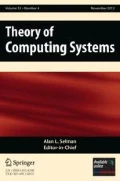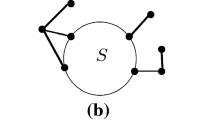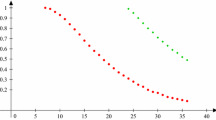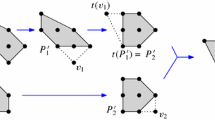Abstract
Denoting the nonnegative (resp. signed) integers byN (resp.Z) and the real numbers byR, letK ⊂ R m andf: R m → R. Thenf is astoring function (resp.packing function) onK wheneverf|(Z m ⊒ K) is an injection into (resp. bijection onto)N. Unit translations gm of some P. Chowla [1961] polynomials are packing functions on the correspondingN m, and all compositions of these polynomials yield further packing functions on variousN r. We study this accessible family of packing functions, using standard properties ofordered trees to classify all those compositions, up to a simple equivalence, which define polynomial packing functions on eachN m. The numberc(m) of equivalence classes is an exponentially growing function for largem, whence the uniqueness conjecture of our prior two-dimensional work has no counterpart for largerm. We obtain the admissible degrees for composition polynomials inm variables; we describe the tre structures for all such polynomials with extremal degrees. Them-variable polynomials of least degree form a rather irregular numbera(m) of equivalence classes. Density considerations give some degree constraints on ageneral polynomial packing function whose domainK is the topological closure of a nonvoid open cone.
Similar content being viewed by others
References
M. Abramowitz and I. A. Stegun,Handbook of Mathematical Functions, U.S. Government Printing Office, Washington, D.C., 1964.
G. Cantor, Ein Beitrag zur Mannigfaltigkeitslehre,J. für die reine und angewandte Mathematik (Crelle's Journal), 34, 242–258 (1878).
G. Cantor, Beiträge zur Begrundung der transfiniter Mengenlehre,Math. Annalen, 46, 481–512 (1895), translated asContributions to the Founding of the Theory of Transfinite Numbers, Dover Publications Inc., New York, 1952.
A. L. Cauchy,Cours d'analyse de l'Ecole Royale Polytechnique, lre partie: analyse algébrique [no others published], l'Imprimerie Royale, Paris 1821, reprinted Wissenschaftliche Buchgesellschaft, Darmstadt, 1968.
P. Chowla, On some polynomials which represent every natural number exactly once,Det Kongelige Norske Widenskabers Selskabs Fordhandlinger 34: 2, 8–9 (1961).
H. Davenport, On a principle of Lipschitz,J. London Math. Soc. 26, 179–183 (1951).
M. Davis,Computability and Unsolvability, McGraw Hill Book Co., New York, 1958.
I. M. H. Etherington, Some problems of nonassociative combinations I,Edinburgh Math. Notes, 32, 1–6 (1940).
R. Fueter and G. Pólya, Rationale Abzählung der Gitterpunkte,Viertelsjahrsschrift der Naturforschenden Gesellschaft in Zürich 58, 380–386 (1923).
P. R. Halmos,Measure Theory, D. Van Nostrand Co., New York, 1950.
D. E. Knuth,The Art of Computer Programming, Second Edition: Volume 1 / Fundamental Algorithms, Addison-Wesley Publishing Co., Reading, Mass., 1975.
J. S. Lew and A. L. Rosenberg, Polynomial indexing of integer lattice-points I,J. of Number Theory 10, 192–214 (1978).
J. S. Lew and A. L. Rosenberg, Polynomial indexing of integer lattice-points II,J. of Number Theory 10, 215–243 (1978).
Th. Motzkin, Relations between hypersurface cross ratios, and a combinatorial formula for partitions of a polygon, for permanent preponderance, and for non-associative products,Bull. Amer. Math. Soc., 54, 352–360 (1948).
G. Pólya and G. Szegö,Aufgaben und Lehrsätze aus der Analysis, Springer-Verlag, New York, 1964, translated asProblems and Theorems in Analysis, Springer-Verlag, New York, 1976.
H. Rogers, Jr.,Theory of Recursive Functions and Effective Computability, McGraw Hill Book Co., New York, 1967.
A. L. Rosenberg, Data graphs and addressing schemes,J. Comput. Syst. Sci., 5, 193–238 (1971).
A. L. Rosenberg, Storage mappings for extendible arrays, in R. T. Yeh (ed.), Current Trends in Programming Methodology IV: Data Structuring, Prentice-Hall, Englewood Cliffs, N.J., 263–311, 1978.
E. Schröder, Vier combinatorische Probleme,Zeits. für Math. Phys. 15, 361–376 (1870).
N. J. A. Sloane,A Handbook of Integer Sequences, Academic Press, New York, 1973.
G. Szegö,Orthogonal Polynomials (revised edition), Amer. Math. Soc., New York, 1959.
H. Whitney,Complex Analytic Varieties, Addison-Wesley Publishing Co., Reading, Mass., 1972.
Author information
Authors and Affiliations
Rights and permissions
About this article
Cite this article
Lew, J.S. Polynomial enumeration of multidimensional lattices. Math. Systems Theory 12, 253–270 (1978). https://doi.org/10.1007/BF01776577
Received:
Revised:
Accepted:
Issue Date:
DOI: https://doi.org/10.1007/BF01776577




